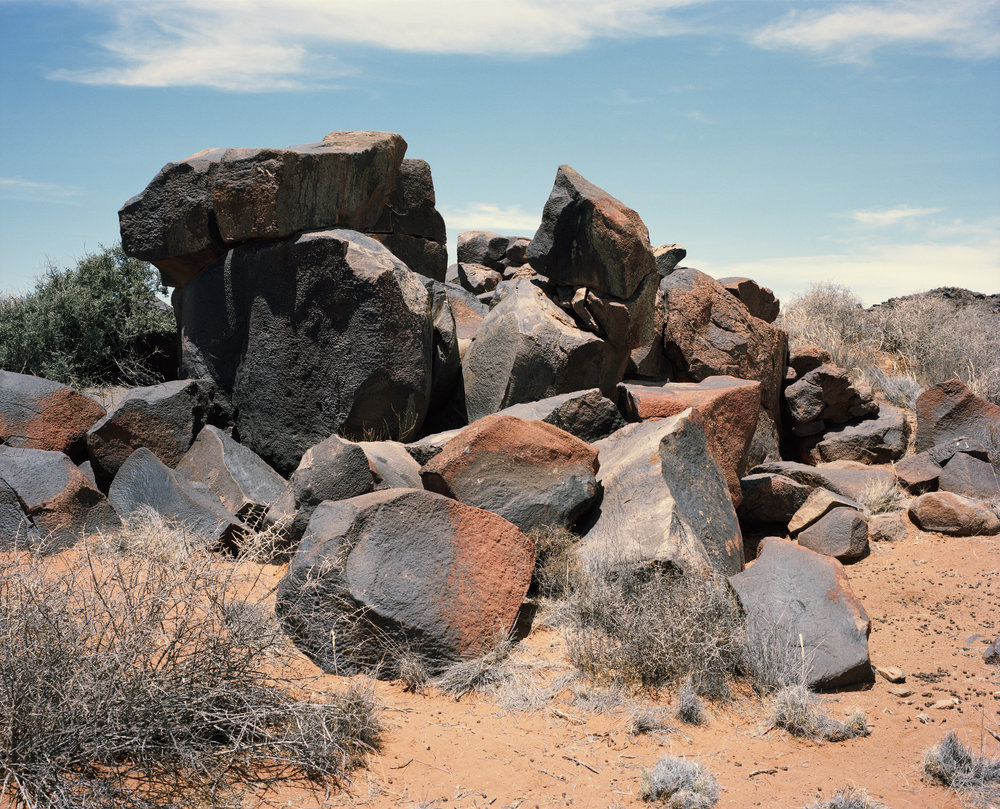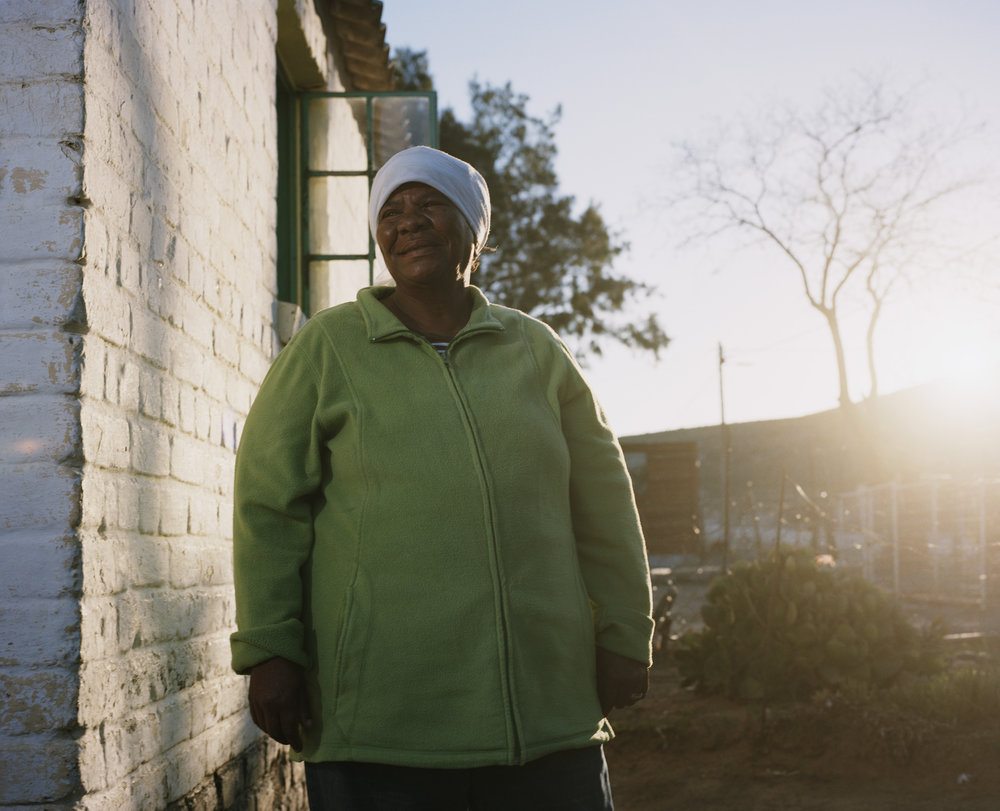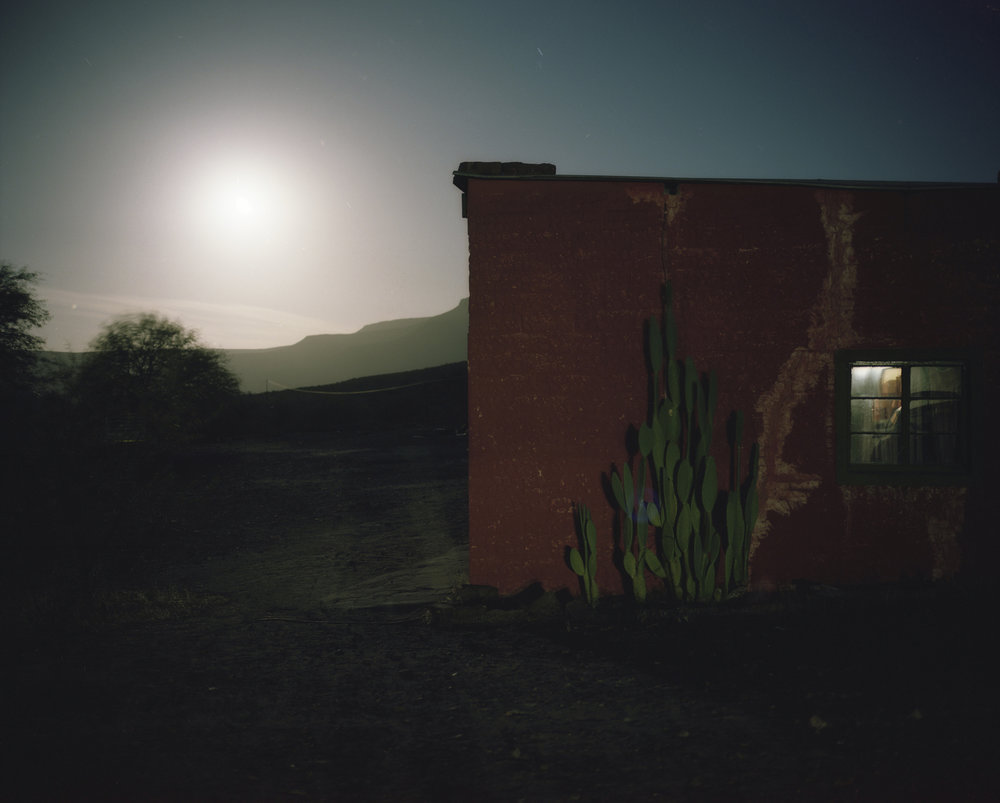BLACK ROCKS #1, between Calvinia and Williston, Northern Cape. Taken from "Hemelliggaam or The Attempt To Be Here Now" (Tommaso Fiscaletti and Nic Grobler)
Skies are rarely the dominant feature in Hemelliggaam or The Attempt To Be Here Now, Tommaso Fiscaletti and Nic Grobler’s four-years-in-the-making photographic, video installation and sound project. Even when they appear, the context within which they are framed suggests them to be part of some fantastical world or an environment beyond the usual limited scope of our quotidian fixations. Light, natural or otherwise, is key in terms of achieving these speculative connections with the extraterrestrial, but as are the specific locations of interest (such as the South African Large Telescope and the Square Kilometre Array), unplanned encounters with strangers and Afrikaans science fiction novels, in particular those selected from the oeuvre of Jan Rabie.“Swart Ster oor die Karoo (Black Star over the Karoo, 1957), Die Groen Planeet (The Green Planet, 1961) and Die Hemelblom (Heaven Flower, 1971) speak to these connections between earth and space,” explain Grobler and Fiscaletti. They consider the work to be an ongoing archive of photography and video installations “exploring existential aspects of the relationship between humans, the environment and astronomy. The project is focused on people, landscapes and objects in the Western and Northern Cape, where there is a special connection with the sky.” In this interview, they speak about the inspiration for the project and how it continues to evolve.

‘We all sat down in this amphitheatre – everyone so excited. Waiting for it to start, and then every now and then a car would arrive in the parking lot and its lights would shine onto the screen and then everyone would freak out a bit. This guy gave a presentation, using like Hubble telescope photographs, each and every photo – incredibly impressive full multicoloured images. This all whilst telling us about the telescopes they themselves have built and that we will be able to see Jupiter with them after the presentation. When we eventually went to look through the telescopes – it was all monochrome tiny little things, no multicolored Hubble stuff. Anyway, it was so great though seeing these old guys, listening to Led Zeppelin, who go up there every two weeks, observing through the night. It’s their thing, it is like playing golf to them’. Dennis Williams, visitor to Cederberg Astronomical Observatory. (Tommaso Fiscaletti and Nic Grobler)
How did you decide what the project would be because it is very broad in scope?
Fiscaletti: It started with some conversations because we were friends before we became project partners. We were talking for maybe a year about a possible project, collecting ideas for many months but we started to realise what was happening after the first trip.
Grobler: Some of the first thoughts or inspirations were connected to a type of awareness around space and us as humans being inside or a part of it. We also realised that there is a deep cultural history and incredible discoveries in the astronomical heritage we have in South Africa – so it made a lot of sense for us to learn and explore more of it.

‘Are we alone, I don’t know – the thing is we will probably never know. If we find a civilization that can signal to us, we’ve got to be able to signal to them. If they are a 100 light years away we are talking about a 100 years between every communication, and by then the other one may have died out or they may have not reached the communications technology or we may have blown ourselves up enough to have to start all over again. So we will probably not communicate with anyone out there – not in our lifetime. But there is probably someone. We are so proud that we call them aliens – we may be the aliens. Who knows.’ Chris Forder. Amateur Telescope builder. (Tommaso Fiscaletti and Nic Grobler)
How did the specific locations emerge?
G: Our main destinations are usually inspired by locations of astronomical significance, like the observatories, and places that have a connection with scenes or characters from science fiction books. On the practical side, the two astronomers of our scientific team, Mattia [Vaccari] and Lucia [Marchetti] helped us to also get some crucial connections in the field. As we travel to some of the more obvious locations, we always experience new things along the way and are open to seeing where it takes us. Some of my favourites trips have been to the Cederberg Astronomical Observatory, the Tswaing meteorite crater north of Pretoria and our search for Langenhoven’s dog Jakhals, who we found in Klaarstroom near Oudtshoorn where he spent time writing. All of these provided ample opportunity for serendipity and we often feel like the best works came out of an unfolding experience and less from strict planning schedule or asking for permissions.

BLACK ROCKS # 1, BETWEEN CALVINIA AND WILLISTON, NORTHERN CAPE. These rocks contain a high percentage of iron and their dark appearance forms a truly ancient landscape. The rocks make a metal sound when played; they are referred to with different names such as ‘rock gongs’, ‘ringing rocks’ or even ‘bushman pianos’. Found in various areas around the world and Africa, tradition formed around communicating with the help of the rocks – evident by the ancient drumming marks often found on them. (Tommaso Fiscaletti and Nic Grobler)
To what extent are you both fans of science fiction and how did that become one of the ways to formulate ideas together?
F: I really like how science fiction can evoke thoughts around different possibilities: some of the stories we are mentioning in the project are about life on other planets, or self consciousness as a way to understand the reality and the human condition. I’m Italian so I am discovering a lot of these local texts through conversations with Nic. From there we go to the visual side where we try to imagine what can happen through photography and video, to be there on the border between fiction and reality. Usually we are not showing something that is staged, we are just there trying to imagine a different possible context. The viewer can then also visualise something new that is not [always physically] there.
Nic, can you recall when you encountered, for example, the writings of Jan Rabie and started to delve into the legacy of his work?
G:I didn’t necessarily grow up as this sci-fi fanatic. I was aware of some of the books but it actually happened when I was in my early twenties while I was camping with my father, there was a radio programme on in the car and I believe they could have been acting out excerpts from Jan Rabie’s Die Hemelblom. I remember hearing like spaceship sound effects and doors that opened in automatic ways, a bit like Star Trek. I was quite surprised in some sense and it was actually funny hearing those things in Afrikaans and it just stayed with me. Naturally I started collecting the books over the years. Now we have maybe like 12 of them and I really like them as physical objects. The earliest is from 1923 and then the ones we have most interest in are from ‘57, ‘61 and ‘71. When you go deeper it becomes more about what inspired the writers and how it relates to the consciousness of their time.
At what point did you decide that the stories of the sitters would be pivotal in the project? Did you go into these interviews trying to establish anything in particular?

ANNA SKIPPERS # 2 SUTHERLAND, NORTHERN CAPE. ‘That was the most beautiful to me, when there is a shooting star, I always believed you could make wish – for good luck. Then I asked some questions and they answered, ‘o, no – when there is a shooting star, it means it is dead and it is going to fall’ and there where it falls, everything must just pray and ask ‘God don’t let it fall on a house, don’t let it fall on a person’ – because it can burn and kill, and you don’t know if it has fire inside, you don’t know if it has hail inside or even iron inside.’ Anna Skippers, Kamammas Community centre coordinator, Sutherland, Northern Cape. Anna lives in Sutherland, close to the largest optical telescope in the Southern Hemisphere. (Tommaso Fiscaletti and Nic Grobler)
G: We both like to think of meeting people as encounters, not necessarily as interviews. It’s not a factual or documentary type project. It was like a moment or a concept that we tried to illuminate. The project is so broad in a sense, including science fiction, landscape and nature. We thought it important to highlight some underlying thought that went through us and through the person in that moment. That is where the character emerges.
F: It’s so wide a theme that each of the people we met tried to explore our questions in their own personal way. The project is really existential in that sense.
Since last year, an exhibition of the project (Chapter One) has been travelling back to some of the sites and towns that were part of the contents. Bringing back Hemelliggaam or The Attempt To Be Here Now to the people that are part of it is an important detail for us. (The Chapter One exhibition is currently on view in Carnarvon, Northern Cape, till the end of August.)
How did you work out the practicalities of working together on this project?
G: We both come from slightly different backgrounds. Tommaso has worked as a professional photographer much more extensively than me. I’ve worked a little bit more in video as well. We’ve found a way to alternate and work together but also support each other.
Sometimes when one of us sees something to be captured, be it through photography or video, we just take the initiative. We feel very free with each other to do what we like, but of course we have certain styles and they cross pollinate.
F: We just opened the conversation and the project definitely became better from there. We usually try to work on all the content together.
G: It’s also nice to be just two people working together, especially when you are meeting someone. It’s great to be able to have a personal conversation and an encounter with somebody and be able to capture it at the same time.
F: It’s definitely an experiential project especially given the time (four years so far) that we have been working on it. It’s the longest project that I have been working on in my life.
P Having conversations with each other while we travel is definitely part of the making, along with encountering things along the way, being surprised by things and being touched by others.
F: For instance on the sci-fi side, it’s really important that I am given an interpretation of all the books because most of them are in Afrikaans. So it’s really amazing for me that what I am trying to capture in pictures is something that is coming from Nic.
In some sense it’s a landscape project but there really is a transcendental quality to the images. Sometimes it is the uniqueness of the terrain itself, in others it how the landscape is presented. What was key in achieving this quality to the images?

FULL MOON # 3, CEDERBERG. (Tommaso Fiscaletti and Nic Grobler)
G: For me it was in the experience the landscape, especially if you think of earth as a heavenly body through the medium of photography, which is just capturing the projections of light. It is the sun as one light source most of the time, but in most of the photographs there is a slight unearthly feeling achieved by introducing a secondary light source. This is something Tommaso likes to do also in much of his other work. The photographic attempt is to bring attention to objects and landscapes in a way that you [feel you] are looking at something in the universe and not just something on earth. It’s basically looking at everything as a heavenly body. So the Attempt to be HereNow is thinking about how and what we are in that moment…
F: That’s why there are no stars or sky in the project. We are trying to look at the earth as full of heavenly bodies everywhere. The upside down landscapes in the second chapter are like the perfect description of this feeling. The Karoo landscape becomes our sky.
I also think that in the video part, the work on the sounds with Alessandro Gigli is definitely useful to find a deeper connection with places and atmospheres.
G: Some landscapes look otherworldly and, I guess, in some way, planetary. If you remove yourself far enough from the earth you will see a planet – a big ball. We can’t remove ourselves that far that easily but we tried to record what we see here in a way that evokes the idea of a planet.
The project is curated by Filippo Maggia, and is supported by a scientific team from UWC (the University of the Western Cape), The National Research Foundation, The Consulate of Italy in Cape Town and Farnesina (Ministry of Foreign Affairs of Italy). The original sound for the project is composed by Alessandro Gigli.
Chapter One of “Hemelliggaam or The Attempt To Be Here Now”, is on display at the Carnarvon Museum and Kareeberg Library Northern Cape, until the end of August 2019.
A Preview of the Chapter Two, will be on view at Fondazione Sandretto Re Rebaudengo in Turin, Italy, September 2019 .
The complete project will be on view in South Africa and abroad from 2020.
(www.hemelliggaam.com instagram: @hemelliggaam)